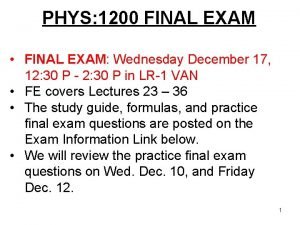U S History Final Exam Materials Semester 1













- Slides: 13

U. S. History Final Exam Materials Semester 1








“After the Egyptian and Indian, the Greek and Roman, the Teuton and Mongolian, the Negro is a sort of seventh son, born with a veil, and gifted with second-sight in this American world, —a world which yields him no true self-consciousness, but only lets him see himself through the revelation of the other world. It is a peculiar sensation, this doubleconsciousness, this sense of always looking at one’s self through the eyes of others, of measuring one’s soul by the tape of a world that looks on in amused contempt and pity. One ever feels his two-ness, —an American, a Negro; two souls, two thoughts, two unreconciled strivings; two warring ideals in one dark body, whose dogged strength alone keeps it from being torn asunder. The history of the American Negro is the history of this strife, —this longing to attain self-conscious manhood, to merge his double self into a better and truer self. In this merging he wishes neither of the older selves to be lost. He would not Africanize America, for America has too much to teach the world and Africa. He would not bleach his Negro soul in a flood of white Americanism, for he knows that Negro blood has a message for the world. He simply wishes to make it possible for a man to be both a Negro and an American, without being cursed and spit upon by his fellows, without having the doors of Opportunity closed roughly in his face”.



“They were smart and sophisticated, with an air of independence about them, and so casual about their looks and clothes and manners as to be almost slapdash. I don't know if I realized as soon as I began seeing them that they represented the wave of the future, but I do know I was drawn to them. I shared their restlessness, understood their determination to free themselves of the Victorian shackles of the pre-World War I era and find out for themselves what life was all about. ” -Colleen Moore

The Struggle for Women's Suffrage Among the most radical of all struggles in American history is the on-going struggle of women for full equality. The ideals of the American Revolution raised women's expectations, inspired some of the first explicit demands for equality, and witnessed the establishment of female academies to improve women's education. By the early 19 th century, American women had the highest female literacy rate in the world. As American states widened suffrage to include virtually all white males, however, they began denying the vote to free blacks and, in New Jersey, to women, who had briefly won this privilege following the Revolution. In the 1820 s and for decades to come, married women could not own property, make contracts, bring suits, or sit on juries. They could be legally beaten by their husbands and were required to submit to their husbands' sexual demands. During the early 19 th century, however, a growing number of women became convinced that they had a special mission and a responsibility to purify and reform American society. Women were at the forefront of efforts to establish public schools, abolish slavery, and curb drinking. But faced with discrimination within the anti-slavery movement, Elizabeth Cady Stanton and others organized the first Women's Rights Convention in Seneca Falls, New York, in 1848. The quest for full equality involved not only the struggle for the vote, but for divorce, access to higher education, the professions, and other occupations, as well as birth control and abortion. Women have had to overcome laws and customs that discriminated on the basis of sex in order to overcome the oldest form of exploitation and subordination. Source: http: //www. digitalhistory. uh. edu/era. cfm? eraid=11
 Us history final exam study guide
Us history final exam study guide World history first semester exam review
World history first semester exam review Us history final semester 2 review
Us history final semester 2 review World history semester 1 final exam study guide answers
World history semester 1 final exam study guide answers World history fall final review answers
World history fall final review answers English 2 final exam review
English 2 final exam review Difference between lytic and lysogenic cycle
Difference between lytic and lysogenic cycle Earth science final exam answers
Earth science final exam answers Final exam review algebra 1
Final exam review algebra 1 Spanish 1 semester 1 final exam answer key
Spanish 1 semester 1 final exam answer key Physics semester 1 final exam study guide answers
Physics semester 1 final exam study guide answers English 12 a semester exam
English 12 a semester exam Apes semester 1 review
Apes semester 1 review World history semester 2 final review packet
World history semester 2 final review packet
























